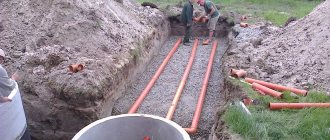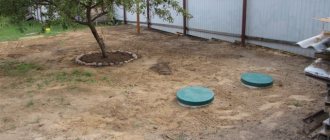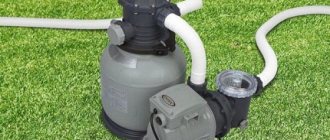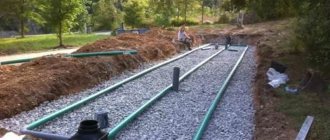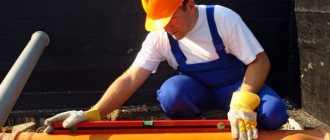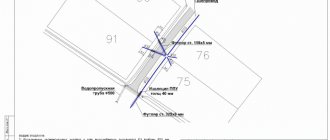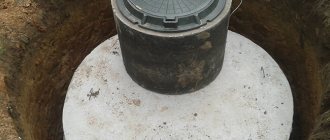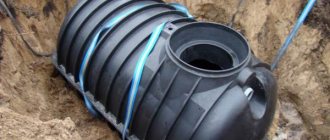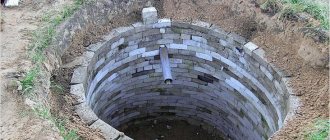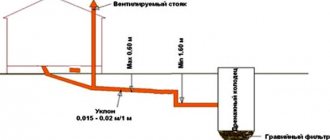The drainage system of country houses, cottages, and summer cottages has its own specifics. The sanitary condition of the site, the quality of vegetables, herbs, berries and fruits collected on the site depend on the choice and installation of treatment facilities . If there is a well or other water intake structures on the site, then poorly treated water will affect its quality.
To receive sewage and primary treatment, special devices are used - septic tanks. After the septic tank, water purification occurs in filtration fields for septic tanks, which can be done with your own hands at no extra cost.
- 2 Scheme and principle of arrangement of the filtration field
- 3 Selecting a location for the filter field. Creating a Project
- 4 Calculation of the size and cost of the filtration field
- 5 How to make a filtration field with your own hands (instructions for installation, excavation work, pipe laying and commissioning)
5.1 Filtration field in clay soil and loam
- 5.2 Scattering field with high groundwater levels and risk of flooding
- 5.3 Arrangement of a filtration field on a sloped terrain
- 5.4 Septic tank with filtration field
- 5.5 Drainage tunnel (as a replacement for the filtration field)
Purpose of the filter field
The drainage field is designed for biological and mechanical purification of water after a septic tank. For the construction of a structure on the site, a special place will have to be allocated. The cleaning device, in addition to the septic tank, is equipped with distribution and dispersion pipes.
Reclamation problem
In and around megacities, the issue of reclamation of old filtration fields . They are filled with imported soil, free of harmful impurities.
The sanitary and epidemiological station checks the soil for environmental hazards. If this area is considered not dangerous, then soil filling may not be done. Former fields are used for various purposes, including agricultural or industrial needs.
Large cities, experiencing a shortage of territory, have been building up old filtration fields with residential complexes in recent years. The most illustrative example is the Lyubertsy fields, located in the Moscow region . Since 2011, the construction of residential apartment buildings has been organized there.
People living in the area complain about the harmful effects of sewage residue on the environment. Thus, sanitary inspection measurements did not reveal any excess of the norm for the content of harmful substances in the soil and air. But the presence of some unsafe chemicals is at critical levels.
Scheme and principle of arrangement of the filtration field
It’s not difficult to figure out how to properly make a filtration field for a septic tank:
- sewage from the plumbing of the house is fed through a pipe into the septic tank;
- suspended substances settle to the bottom of the structure;
- the settled water flows into the distributor;
- The wastewater spreads over the pit area using dispersive tubes and passes through the ground. Filtration from suspended particles occurs;
- Gaseous substances resulting from the activity of bacteria are released from the dispersing system through special ventilation pipes.
Important! The design of the septic tank does not matter for the operation of the filtration field. The main task is to correctly remove and distribute wastewater across the filtration field.
Drainage and sewer pipes are used as dissipative pipes. The required amount is placed at the bottom of a trench or pit, previously filled with a mixture of sand and gravel. The height of the mixture layer is approximately one meter. The sand mixture acts as a filter for wastewater treatment plants.
Are there other solutions?
Not everyone can use the filtration field as a method of post-treatment of sewage waste. What should those who own a piece of clay land or have built a house in an area with a high groundwater level do?
Recommendations for choosing septic tanks for high groundwater levels are described in this article.
Scheme of operation of a biological treatment station. After passing through several tanks equipped with aerators, airlifts and filters, the water becomes 98% pure. The main function of waste processing, as in septic tanks, is performed by anaerobic and aerobic bacteria
It is also possible to create a sewer system with a filter well, but its installation also requires a number of conditions (for example, non-clayey soil and the location of groundwater a meter below the conditional bottom of the well).
If you simply install a septic tank without further treatment, insufficiently clarified and disinfected water will enter the soil and an unpleasant odor may appear.
Selecting a location for the filter field. Creating a Project
For productive and safe operation of the drainage field for a septic tank, it is necessary to draw up a project that clarifies the following points:
- occurrence of water in soils. Acceptable – 1.0-1.5 m;
- distance from the place of water intake, fruit bushes, ridges with herbs and vegetables;
- terrain: the slope should be no more than 0.02 (2 cm per linear meter);
- location of the filtration field in relation to the buildings located on the site (minimum 3 meters);
- dimensions of the filtration field. The area for the field consists of a useful area - an irrigation area and an additional one - ditches for drainage and protective rollers;
- number of pipes, their length and diameter;
- amount of materials for backfilling the trench;
- location of ventilation pipes.
Drainage tunnels
Scheme of operation of drainage tunnels
They are a close analogue of underground filtration fields. The main difference is that instead of perforated pipes, special elements are used here - infiltrators. They are containers with an increased area adjacent to the ground and do not have a bottom. Their volume, depending on the manufacturer, ranges from 300 liters or more.
The effective area of this structure is calculated, as with aeration infiltration fields, based on the area of the sand-crushed stone base. However, in accordance with the calculation table, the coefficient here is 1.4-1.6 versus 0.4-0.6 (for conventional aeration fields).
In other words, the productivity of drainage tunnels is approximately 3 times higher.
Installation of drainage tunnels
The process of installing filtration tunnels
The principle is almost identical to the creation of aeration fields, with the only difference being that instead of perforated pipes, drainage elements are installed.
Installation work consists of:
- Pit preparation;
- Cutting soil from the bottom;
- Gravel base dumps;
- Installation of drainage elements;
- Backfilling with gravel;
- Coverings with geotextiles;
- Final backfill.
Sanitary standards for drainage tunnels are similar to aeration fields and are 15 meters.
After digging a pit, soil is cut from its bottom. Next, a gravel cushion with a thickness of 200 mm is poured. Infiltrators are installed on it, connecting pipes to the septic tank and to each other. At the end of each tunnel, a ventilation fan riser is made with an outlet to a height of 70 cm above the ground level.
If drainage elements with a continuous arch are used, located close to each other, then final backfilling with soil is possible without the use of geotextiles.
If there are gaps between them, geotextiles should first be laid on the walls of the pit to protect the gravel base from mixing with the soil. Next, the drainage tunnels are filled to the top with crushed stone and covered with geotextiles.
For the final backfill, the previously selected soil can be used.
Expert opinion
Dmitry Chernov
Design engineer. Experience in designing wastewater treatment plants - 18 years.
Order installation of a septic tank
All of the above structures do not work at high groundwater levels. When groundwater is close, it is possible to use a filter embankment made of crushed stone with drainage tunnels laid in it. The height must be at least 1 m. However, such a system will be expensive. Drainage from the septic tank by gravity is not possible in this option. Forced supply with a drainage pump will be required.
Calculation of the size and cost of the filtration field
The creation of a filtration field for a septic tank is carried out according to a pre-designed project including the following data:
- area of land for the field;
- preparatory work;
- equipment list;
- calculation of material costs.
In order not to make mistakes when calculating the filtration field parameters for a septic tank, you need to know the amount of incoming water during the day and the composition of the soil.
Knowing these indicators, you can use the table:
Let's say there is a septic tank with a volume of 8 cubic meters. on a site with sandy soil. In the column “Septic tank volume” we find the number 8. In the column “Soil type” – “Sand”. To purify water from a septic tank, you need 4 meters of perforated pipe. This is a rough estimate.
You can find out more about choosing a septic tank based on the number of people living in the house here:
To determine the area of the field, you need to divide the daily volume of wastewater by the soil filtration coefficient.
Based on the data obtained, we calculate the number of pipes, ventilation ducts and backfill made of sand, gravel and soil. After this, we calculate the cost of the structure by adding up the cost items.
When calculating construction costs, you should take into account:
- excavation work;
- purchase and delivery of filter materials;
- price of pipes, connecting devices and geotextiles;
- cleaning up waste land after completion of work;
- project order.
Types of filtration structures
There are 3 types of main drainage systems for a septic tank:
- Filter wells;
- Aeration fields;
- Tunnels.
Their choice depends on the performance of the device and individual conditions on the site.
Filter drainage wells
They are a well with a gravel cushion - a bottom filter at the bottom. Through it, wastewater seeps into the soil, undergoing preliminary treatment.
Fields of underground filtration (aeration)
This is a system of perforated pipes that are laid on a crushed stone bed. The top is covered with soil and covered with geotextile. Unlike wells, they can have a significantly larger wastewater dispersion area and high productivity.
Drainage tunnels
They are a type of underground filtration fields. Instead of pipes, special tunnels or, in other words, drainage elements are used here. They perform the same function as pipes in an aeration field, dispersing runoff. But due to their shape and size, the tunnels significantly increase the effective contact area of the wastewater with the soil and the efficiency of the system.
Possible causes of clogging of the filtration field. How to prevent this
Filtration fields for septic tanks reduce their productivity over time. This is a natural phenomenon caused by a decrease in the throughput of the filter layer. To restore the operation of the structures, it will be necessary to replace the filter layer or move the structure to another location. In other words, the construction of new structures.
But it is not all that bad. The siltation process can be slowed down using a number of measures:
- cover the gravel layer with geotextile to prevent solid particles from penetrating into the filter layer;
- improve the quality of water after the septic tank (correct calculation of the installation volume). The volume of the septic tank is less than the calculated volume, which contributes to the excess supply of suspended solids for treatment;
- purchase a factory-made septic tank. The devices are equipped with biofilters, which allow achieving the required purification from harmful substances (up to 75%).
Installation
Do-it-yourself installation goes like this:
- trenches are dug for laying drainage pipes according to the drawn up project;
- geotextiles are laid in the trenches so that the edges of the fabric protrude beyond the edges of the trenches;
- crushed stone of the middle fraction is poured onto the geotextile, the layer thickness is 40 cm;
- Next, drainage pipes are laid, on top of which a layer of crushed stone 10 cm high is poured;
- after this you need to wrap the geotextile, thus wrapping the filter layer;
- then a layer of sand is poured and the final backfill is carried out with soil.
How to place a septic tank on the site?
Concrete rings are a good material for making sewer systems in private households. If the territory does not belong to environmental protection zones, then you can save on sewerage, since the cost of such a septic tank is half the price of purchasing a treatment station.
Before starting work, it is necessary to determine the type of soil on the site. The choice of filtration system depends on its characteristics, since the design of a septic tank made of concrete rings involves several containers. According to sanitary standards, water must be allowed to settle for three days or more before being discharged into the ground.
The type of soil can be determined by digging a hole, interviewing neighbors who own a well or well, or requesting information from an organization conducting construction or drilling near the site.
The filtration coefficient is slightly higher for loams, slightly higher for sandy loams. However, their filtration properties are still not enough to install groundwater wastewater treatment systems on the listed clay soils.
In addition, almost all clay soils are characterized by heaving - the ability to increase in size during freezing and decrease during thawing. These soil movements can easily push concrete containers out, completely destroy them, or simply squeeze them until cracks appear.
If the site is located in a hilly area, it is likely to have rocky soil. In this case, you need to make a choice in favor of ground-based purification stations or storage tanks
Sand, gravel, pebble and crushed sedimentary rocks have good absorption properties. They freely allow water to pass through their thickness and do not interfere with its movement into the underlying layers.
True, coarse sediments, such as gravel and pebbles, occur mainly in river floodplains, and crushed stone is at the foot of mountain formations.
The throughput capacity of clay is practically zero. This type of soil belongs to the category of aquicludes - water-repellent rocks that do not absorb or allow water to pass through its thickness.
On river and mountain slopes, filter structures are not suitable, because Part of the drainage liquid will not be able to undergo a post-treatment cycle sufficient for disposal into the ground.
Therefore, sandy soils of all degrees of coarseness and density, except for dusty ones, are considered normal conditions for constructing filtration fields, absorption wells and installing infiltrators.
In addition to geological conditions, it is necessary to comply with the norms of its location from residential buildings and water sources.
This information is specified in sanitary standards and must be followed. You should avoid locating the septic tank close to where trees grow, as their root system can cause damage to the structure
If sanitary standards are neglected, biological contamination of water may occur. Dangerous pathogens of infectious diseases develop in sewage. These include E. coli, which causes severe poisoning. It easily reaches the source of drinking water through groundwater.
Vertical infiltration field.
Vertical infiltration fields allow water to be pumped into sand layers located at a depth of more than 4 m.
Before making a decision to build vertical infiltration fields, it is necessary to conduct a geological study of the soil.
Discharge into aquifers is prohibited. This type of infiltration fields is done together with a company specializing in well drilling.
For more detailed information about the vertical type infiltration field, see here: vertical drainage
Aeration process
In a broad sense, aeration is the process of saturation with air or oxygen . This is where the name comes from: “aero” translated from ancient Greek as “air”. During aeration, the incoming air and the oxygen it contains comes into close contact with water. The purposes of this are very different:
- Saturation of water with oxygen necessary for the life of living creatures and plants living in it.
- Oxidation of iron impurities contained in water (“deferrization”).
- Removal of harmful dissolved gaseous impurities - carbon monoxide, hydrogen sulfide, etc.
In the case of filtration fields, aeration is carried out by regularly plowing the soil. The air entering the soil promotes the development of microorganisms that process organic sewage residues.
